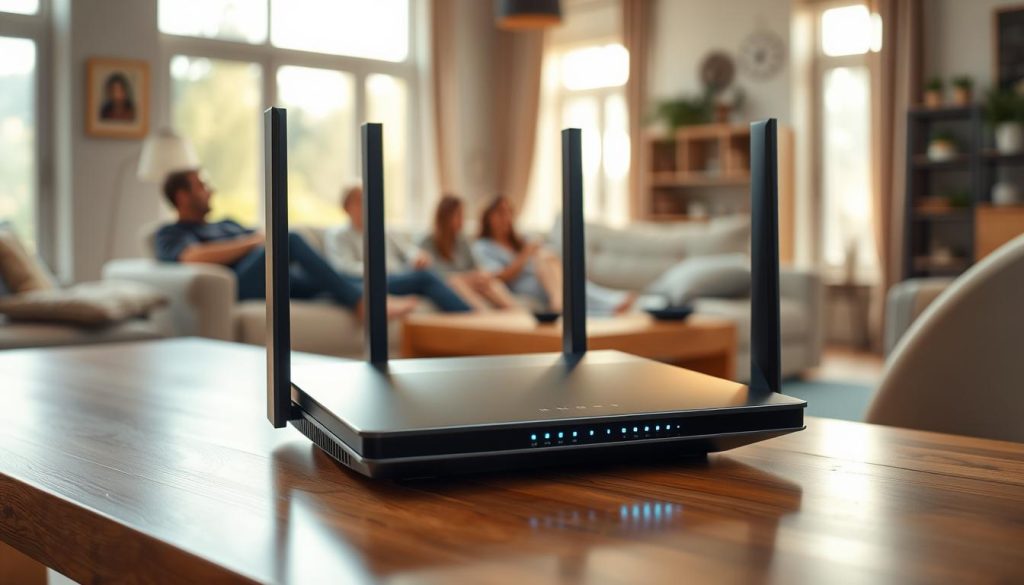Welcome. This short guide explains why network security matters and how you can make your home or small office safer right now.
You will learn practical steps to stop eavesdroppers, cut bandwidth theft, and shield files from casual intruders. The measures are simple: change default router credentials, enable WPA2 or WPA3, rename SSIDs without personal data, and turn on your firewall.
HomePrivacyNetwork.com offers clear how‑tos, product reviews, and videos to help protect your devices. This article focuses on best practices that deliver the biggest gains against online threats while staying easy to follow.
You’ll see how a layered approach—router settings, Wi‑Fi encryption, access control, and endpoint care—keeps your systems resilient. Follow these steps and keep checking our blog and YouTube channel for updates as threats evolve.
User intent and what you’ll learn today
This guide gives a short roadmap so you can get started quickly and reduce common threats to your connected home. You’ll focus on high‑impact actions that protect devices, limit exposure, and help you keep sensitive information private.
Start by checking your router dashboard (commonly at 192.168.1.1). Once inside, rename the SSID, change the default admin credentials, enable WPA2 or WPA3, update firmware, and confirm the firewall is active.
- Clear plan: a short checklist you can complete today to get started fast.
- Core best practices: admin credentials, encryption, firmware, and minimal services.
- Exposure points: where information is likely to leak and how to close those gaps without costly tools.
- Common threats: from opportunistic Wi‑Fi piggybacking to basic malware and phishing.
- Learning resources: hands‑on videos and step‑by‑step articles you can follow at your own pace.
HomePrivacyNetwork.com maps these steps into clear how‑tos and reviews so you can strengthen your home network efficiently. Use the checklist here, then visit our YouTube channel and blog for guided walkthroughs and deeper information.
Quick start: Five actions to reduce risk right now
Complete these five actions in minutes to lower your risk from opportunistic online threats.
Get started by opening your router dashboard (often at 192.168.1.1). Change the default admin username and password to a unique, strong combination. This stops automated scans that use factory credentials.
Enable WPA2 or WPA3 and choose a long, unique Wi‑Fi passphrase. This step blocks casual credential guessing and reduces exposure to online threats.
- Update firmware from the router dashboard and turn on automatic updates if available to patch known vulnerabilities.
- Limit services by disabling guest Wi‑Fi or isolating it, and turn off unused features like media servers or remote admin to cut attackable surfaces.
- Verify clients by checking the DHCP Clients Table; remove or block unfamiliar devices and investigate unknown MAC addresses.
- Reduce exposure by rebooting or powering down the router when you won’t be online for long.
- Document changes so you can repeat these steps after a reset or hardware swap and keep improvements durable.
These concise steps help make your network more resilient and protect connected devices. For walk‑throughs of these quick wins, check the HomePrivacyNetwork.com YouTube channel and blog to get started with hands‑on guides and product reviews.
About HomePrivacyNetwork.com: How we help you protect every device, anywhere you connect
Our mission is to help you make safer choices for devices and connections, using clear how‑tos and media you can trust. You’ll find practical guidance that keeps cybersecurity simple and actionable.
Visit our YouTube channel for hands-on walk‑throughs
Watch short videos that show each recommended step on real routers and devices. You can follow along to change default admin credentials, enable WPA2 or WPA3, update firmware, and check the DHCP Clients Table.
Check our internet security blog for new guides, reviews, and how‑tos
Visit our blog at www.homeprivacynetwork.com to read each article and stay current with device changes. We publish product reviews, comparisons, and clear instructions that help protect your information and devices.
- Follow hands‑on videos that map directly to our written guides.
- Rely on timely articles about router security, firmware updates, and firewall checks.
- Learn to harden a connected home network without new hardware by using smarter defaults and trimming unused services.
- Expect regular updates so your security guidance stays aligned with evolving threats and software changes.
Foundations: How networks get compromised and what prevents unauthorized access
Understanding how attackers breach home and small office connections helps you close common entry points.
Unprotected wireless signals let nearby people join your system and probe shared folders. That can lead to eavesdropping, bandwidth theft, and exposure of sensitive data.
Password reuse, default admin logins, and unpatched firmware make simple exploits effective. Even unsophisticated attackers use automated tools to find these weak spots and launch basic attacks.
Encryption like WPA2 or WPA3, strong admin credentials, and the router’s built‑in firewall are primary best practices that raise the bar quickly. These measures enforce authentication and block unsolicited inbound connections that cause unauthorized access.
- Open Wi‑Fi lets nearby parties probe for lax device permissions and shared files.
- Reused or default passwords and old firmware make common exploits trivial.
- Layered controls—encryption, firewalls, and careful sharing—protect your information.
Adopt small, consistent defenses together. Multiple modest controls reduce the chance of successful breaches and keep daily use simple for your household or team.
Tips for setting up a secure network
Focus on high‑impact changes that protect your devices immediately. Start with basic controls that apply to both homes and small offices so you have a safe baseline before adding more gear.
Home versus business: the same core actions work in both places: change default admin credentials, enable WPA2 or WPA3, rename the SSID without personal data, disable unused services, and make sure the router firewall is active.
For a small office, add documentation, access policies, and routine checks across all devices. Keep an inventory of what connects and postpone nonessential gadgets until essentials are locked down.
- Baseline — change admin login, enable modern encryption, and turn on the firewall.
- Hardening — disable built‑in services you don’t use (media server, USB storage) to remove potential vulnerabilities.
- Maintenance — choose vendors that issue long‑term updates so you get better security with less manual effort.
| Environment | Core actions | Extra steps |
|---|---|---|
| Home network | Change admin, enable WPA2/WPA3, neutral SSID | Inventory devices, disable unused services |
| Small office | All home actions plus documentation | Access policies, periodic audits, staff guidance |
| Both | Keep firmware updated and firewall enabled | Prefer vendors with long update cycles |
Harden your router first: Admin login, firmware, and baseline security
Start by securing the device that governs your home traffic. Small changes on the router cut many common risks and give you control over connected devices.
Change default admin username and password
Access the router at 192.168.1.1, log in, and immediately replace factory credentials. Use a long, unique password and a nonstandard username to stop automated scans.
Update firmware and enable automatic updates
Open the router dashboard and check the firmware page. Install the latest release and turn on auto updates when available to patch known flaws.
Disable unused services and remote administration
Turn off remote administration and features you don’t use, such as media or file sharing. Fewer services reduce exposure and simplify management.
Make sure the firewall is enabled and configured
Verify the built-in firewall blocks unsolicited inbound connections while allowing normal outbound traffic. Save a backup of your configuration and remove unneeded plugins or software.
- Change default admin name and set a long password.
- Install firmware updates and enable automatic patching.
- Disable remote admin and unused services to limit access.
- Confirm firewall rules and keep a config backup.
Our tutorials walk you through each step on popular brands so you can replicate settings confidently at home or work.

Wi‑Fi security done right: SSID, encryption, and guest access
A well-named SSID and correct encryption settings reduce many common points of attack.
Rename the SSID to a neutral label that avoids your name, apartment number, or other personal information. This simple change lowers the chance someone targets your home network based on personal data.
Enable WPA2 or WPA3 under wireless security and set a long, random passphrase. Apply the change on both 2.4 GHz and 5 GHz radios so every band uses the same strong encryption.
- Rename the SSID: pick a neutral name that reveals no personal information.
- Use modern encryption: select WPA2 or WPA3 and create a unique, long passphrase.
- Apply to all bands: update both 2.4 GHz and 5 GHz so devices use consistent protection.
- Guest Wi‑Fi: disable it if unused; if kept, isolate guests from your main LAN to limit unauthorized network access.
- Guest controls: make sure router options block guest-to-guest traffic and prevent guest access to admin pages.
After changes, reconnect your devices and remove old saved profiles on phones and laptops. Periodically review the DHCP clients list and revoke credentials for devices you no longer use.
Note: we show these SSID and encryption steps in companion videos across major home Wi‑Fi systems to help you apply the same actions on your router.
Access controls and MFA: Limit who and what can connect
Make access decisions deliberate: deny by default, grant only what each account needs, and log changes. This approach reduces the chance of unauthorized access and keeps sensitive data safer.
Principle of least privilege
Grant the minimum permissions users and services need to work. Create separate admin accounts and avoid using them for daily tasks.
Document permissions and review them quarterly to remove stale access. We provide policy templates and checklists you can adapt to keep home office permissions minimal and auditable.
Enable multi‑factor authentication on critical services
Turn on MFA for email, cloud storage, router cloud apps, and remote portals. A second factor cuts account takeover risk dramatically.
Use app‑based authenticators or hardware keys where possible. Treat MFA as mandatory for any account that touches sensitive data or can change device settings.
MAC address filtering: value and limitations
Whitelist known device MACs to reduce casual access. This adds friction for intruders but can be bypassed by spoofing.
Treat MAC filtering as a minor layer—combine it with strong passwords, MFA, and device isolation to improve overall network security.
- Default to deny; grant only needed permissions.
- Separate admin from daily accounts to protect sensitive data.
- Limit guest and IoT device access to internet-only segments.
- Review and document access quarterly so your model stays current and auditable.
Reduce your attack surface: Fewer devices, fewer services, fewer risks
Every extra gadget and enabled feature increases the chance someone finds an entry point. Reduce the number of active items to lower that risk and simplify management.
Unplug or disable devices you rarely use. In a connected home, each online device adds a task to monitor and update. Fewer items mean fewer things to break or forget.
Turn off auxiliary services like media servers or storage sharing when not needed. Disabling unused services removes common attack vectors and shrinks the list of potential vulnerabilities.

- Unplug or power down idle gadgets so they stop broadcasting.
- Disable router and NAS services you do not use to cut exposure.
- Prefer function over novelty when adding devices to keep complexity low.
- Keep a simple inventory of each device and why it is online; review it monthly.
Make changes explicit: switch default “on” settings to opt‑in so new items do not add unwanted services automatically. This habit reduces routine risk and makes network upkeep predictable.
| Action | Why it helps | When to apply |
|---|---|---|
| Remove unused devices | Fewer endpoints to patch or monitor | Monthly review or after guests leave |
| Disable extra services | Eliminates common scanning targets | Immediately, and after firmware changes |
| Maintain device inventory | Clear scope for management and audits | Update whenever you add or remove hardware |
Following these steps makes network management easier and raises overall security while making network threats less likely to succeed.
Segment your network to protect sensitive data
Logical separation of devices limits lateral movement when an exploit affects one gadget.
Create clear segments so each class of device has its own zone. Use VLANs or separate SSIDs to keep IoT, guest, and work clients apart. This reduces how threats move across your home infrastructure.
Separate IoT, guest, and work devices with VLANs
Place smart home devices on a dedicated VLAN or SSID so they cannot reach your workstations that hold sensitive data. Isolate guest Wi‑Fi into its own segment with client isolation so visitors cannot browse your assets.
Control traffic between segments with firewall rules
Write simple allow‑only firewall rules per segment, then block all else. Allow IoT to reach the internet but block access to laptops, NAS, and admin ports. Apply access controls at your router or a managed switch so enforcement is centralized and consistent.
- Test rules by trying to reach blocked resources to confirm segmentation works.
- Review logs for denied traffic to spot probing and misconfigurations.
- Share example VLAN layouts and rule sets in your documentation so adjustments are repeatable.
Endpoint defense: Up-to-date antivirus and anti‑malware across devices
Make sure every device runs updated security software and scheduled scans to catch new threats. Outdated tools miss variants that arrive daily and leave holes attackers exploit.
Install reputable suites on laptops, desktops, and phones. Enable real‑time protection, web filtering, and automatic definition updates so the software adapts to new viruses and online threats.
- Turn on automatic updates to keep definitions current and reduce manual work.
- Schedule quick scans daily and full scans weekly to find dormant infections.
- Keep each device’s local firewall active so endpoint defense joins your broader network protections.
Compare suites by looking at malware detection, system impact, and web protection. Below is a concise comparison to guide your choice.
| Product | Strengths | Best use |
|---|---|---|
| Windows Defender | Built‑in, low system impact, good real‑time protection | Windows users who want managed, free coverage |
| Bitdefender | High detection rates, robust web filtering, minimal slowdowns | Homes and small offices needing strong, all‑around protection |
| Malwarebytes | Excellent malware removal and layered scans | Complementary scans for systems with suspected infections |
Action now: pick a reputable option, enable auto updates, and set scheduled scans so devices remain resilient against evolving attacks.
Maintain and update security infrastructure continuously
Make routine maintenance a habit: timely patches and checks keep most common intrusions at bay.
Set a predictable cadence so you can plan work and avoid missed updates. Our maintenance checklists include monthly and quarterly tasks you can calendar and follow without guesswork.
Patch operating systems, applications, and firmware on a schedule
Establish a monthly patch day so operating systems, apps, and device firmware stay current by a predictable date.
Automate updates where safe, and apply critical fixes immediately. Track what you updated and when so you can roll back if an update causes issues.
Remove unnecessary software and close unused ports
Uninstall outdated or unused software and disable services you no longer need. This reduces exploitable code and lowers maintenance overhead.
Close unused ports in your router and endpoint firewalls. Fewer open ports means less exposure to random scans and targeted probes.
Monitor network traffic for unusual activity
Review router and switch dashboards for spikes, strange destinations, or persistent connections that don’t match daily use.
Keep simple logs of what you updated and when. Logs help you trace issues back to a specific change and speed incident response.
- Establish a monthly patch day and quarterly security review.
- Remove unused apps and disable idle services.
- Close unnecessary ports on endpoints and the gateway.
- Monitor network dashboards and inspect anomalous traffic.
| Task | Frequency | Why it matters |
|---|---|---|
| Apply OS and app patches | Monthly (+ urgent fixes) | Prevents exploitation of known flaws |
| Update device firmware | Quarterly or per vendor alert | Fixes router and appliance vulnerabilities |
| Remove unused software / services | Every patch cycle | Reduces attack surface and maintenance load |
| Monitor logs and traffic | Weekly review | Detects anomalies early and aids troubleshooting |

Encrypt data in transit and at rest
Use modern encryption across Wi‑Fi, browsers, and backups so your information stays unintelligible to intruders. Small changes make a measurable difference against common online threats.
Start with your wireless: enable WPA2 or WPA3 to encrypt local traffic and cut eavesdropping risk. Prefer WPA3 when your devices support it.
Strong Wi‑Fi encryption and secure protocols (HTTPS, TLS, VPN)
Favor HTTPS/TLS sites and enable browser modes that block insecure fallbacks. We offer walkthroughs to enable HTTPS‑only modes and to configure basic VPN clients so you browse more safely on public hotspots.
When using untrusted Wi‑Fi, use a reputable VPN to shield traffic from local snooping and rogue access points. This adds an extra hop of protection beyond browser TLS.
Protect backups and sensitive files with encryption
Encrypt external drives and cloud backups so lost or stolen media does not reveal your files. Store decryption keys in a password manager or hardware key and test recovery periodically.
- WPA2/WPA3: encrypts local wireless traffic.
- HTTPS/TLS: keeps web sessions private in transit.
- VPN: protects traffic on public hotspots.
- Encrypted backups: prevent unauthorized access to stored data.
- Key management: store and test decryption keys regularly.
| Layer | What to enable | Why it matters |
|---|---|---|
| Local Wi‑Fi | WPA2 or WPA3 | Stops nearby eavesdroppers from reading traffic |
| Web traffic | HTTPS/TLS + HTTPS‑only browser mode | Protects credentials and site data in transit |
| Backups | Disk/cloud encryption and tested key storage | Ensures lost media does not reveal sensitive files |
Back up your data and test recovery regularly
Plan backups so you can recover quickly when hardware fails or malware strikes.
Apply the 3‑2‑1 rule: keep three copies of your important information, store them on two different media, and keep one copy off‑site or in the cloud.
Schedule regular backup jobs and verify they finish by checking logs and doing spot restores on a set date each quarter. This prevents silent failures and confirms restorations meet your time goals.
Follow the 3‑2‑1 strategy and run recovery drills
Run recovery tests that simulate real incidents so you can restore files under pressure. Include scenarios for hardware loss, ransomware attacks, and accidental deletions.
- Keep one offline or off‑site copy to reduce risk from ransomware.
- Document backup locations, encryption keys, and restore steps so anyone can act under pressure.
- Use printable 3‑2‑1 checklists and recovery drill templates to practice restores and improve outcomes.
By treating backups as an active part of security, you lower long‑term risk and protect your network and business continuity.
Operational tips: Turn off equipment, check connected clients, and audit
Simple daily habits make a big difference in spotting unknown devices and unusual traffic on your home systems.
Use your router dashboard and open the DHCP Clients Table to see every active client. Our videos show common brand dashboards and how to read hostnames and MAC addresses so you can identify what belongs and what does not.
Power down the router when it won’t be used; this reduces exposure and saves electricity. Disable unused media or file sharing features and verify they stay off after firmware updates.
Practical checks you can run
- Review the DHCP Clients Table regularly to confirm each device is expected on your network.
- Remove or block unfamiliar entries and change Wi‑Fi credentials immediately to kick off any unauthorized network connections.
- Schedule audits: monthly quick checks and quarterly deeper reviews so drift does not undo your work.
- Watch for odd traffic spikes or devices showing up at odd hours — these are early signs of compromise.
| Action | Why it matters | Frequency |
|---|---|---|
| Inspect DHCP clients | Find unknown devices and confirm legitimate hosts | Weekly |
| Disable media/file sharing | Removes common attack surfaces | After updates and quarterly verification |
| Power down router | Reduces exposure and saves energy | When away for extended periods |

Recognize and resist phishing attacks to protect your network
A single fraudulent message can give adversaries access to accounts and devices.
Phishing attacks remain a leading vector for credential theft and malware delivery. Train yourself and household members to verify sender addresses and question urgent requests that ask for logins, payments, or sensitive information.
Hover over links before clicking to inspect their destinations. Avoid enabling macros or opening attachments from unknown senders. These simple checks block many common online threats.
- Verify senders: check email headers or contact the sender by known channels when a message seems unusual.
- Inspect links: hover to reveal true URLs and avoid shortened or mismatched domains.
- Protect accounts: enable multi‑factor authentication so stolen passwords alone cannot grant access.
- Report and remove: flag phishing to your provider and delete the message to reduce accidental clicks.
We provide simulated phishing templates and short training exercises that help build safer habits at home and in small teams. Practice reduces human error, which is often the weakest part of any security program.
| Action | What it prevents | How to apply |
|---|---|---|
| Verify sender details | Credential theft | Call or message known contact channels |
| Avoid macros/attachments | Malware delivery | Open only trusted, scanned files |
| Enable MFA | Account takeover | Use app authenticators or hardware keys |
Get started with trusted tools, tutorials, and ongoing learning
Use clear, hands‑on guides that walk you through choosing software, checking services, and testing access. Short lessons make complex steps easy to follow and repeat when devices change.
Watch and read—our YouTube channel shows router screens, menu paths, and verification steps so you can copy actions precisely. Visit the blog at www.homeprivacynetwork.com for updated articles, product reviews, and step‑by‑step guides.
Curated checklists help you keep pace with evolving online threats. They show which settings to verify after an update, how to choose low‑impact security software, and which services to disable safely without breaking essentials.
- Follow tutorials to configure the router and confirm changes after resets.
- Evaluate antivirus and protection suites that match your devices and budget.
- Use maintenance checklists to align daily habits with best practices in network security.
- Consult service hardening guides before disabling features to avoid lost functionality.
- Make continuous learning part of your routine so you adapt as platforms change.
| Resource | What it helps | When to use |
|---|---|---|
| Tutorial library | Step‑by‑step router and device configuration | After purchase, during updates, after resets |
| Software reviews | Choose low‑impact protection with auto updates | When selecting or renewing subscriptions |
| Checklists | Routine verification of settings and services | Monthly and after major updates |
| Hardening guides | Safely disable unused services without breaking access | When trimming features or adding IoT devices |
Conclusion
You now have the essential steps to harden your router, enable strong encryption like WPA2/WPA3, and apply access controls that prevent common threats on a home network and small office.
Commit to regular firmware and software updates and use unique password hygiene so routine attacks lose their edge. Monitor connected devices and the DHCP clients list so anomalies are spotted quickly.
Use segmentation, encryption, and tested backups together so one mistake does not expose all your information. Revisit this checklist by a set date each quarter to keep protections current.
For ongoing help, subscribe to our YouTube channel and visit HomePrivacyNetwork.com to stay confident as you keep your router and devices defended against evolving threats.

